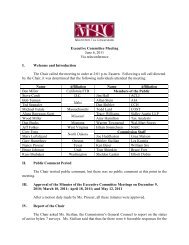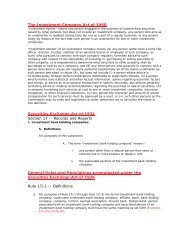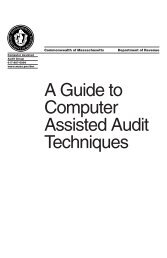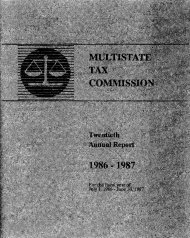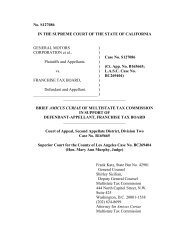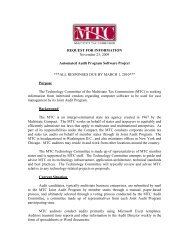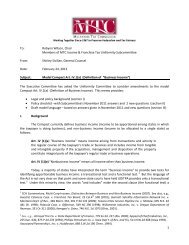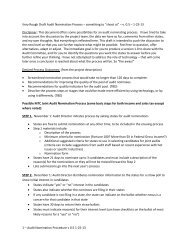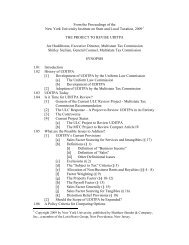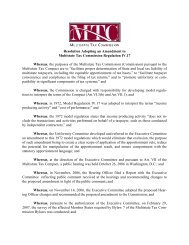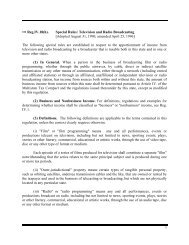Report of Work Group - Multistate Tax Commission
Report of Work Group - Multistate Tax Commission
Report of Work Group - Multistate Tax Commission
Create successful ePaper yourself
Turn your PDF publications into a flip-book with our unique Google optimized e-Paper software.
MULTISTATE TAX COMMISSION<strong>Work</strong>ing Together Since 1967 to Preserve Federalism and <strong>Tax</strong> FairnessTo: Uniformity Committee, Income and Franchise <strong>Tax</strong> SubcommitteeFrom: Lennie Collins, Chair, MTC Financial Institutions <strong>Work</strong> <strong>Group</strong>Date: July 22, 2011Subject: Status <strong>Report</strong>, Financial Institutions ProjectThe purpose <strong>of</strong> this memo is to summarize the current status <strong>of</strong> the Income and Franchise <strong>Tax</strong>Subcommittee project to revise the MTC model apportionment formula for financial institutions.The work group has held regular teleconferences since the subcommittee’s March 2011 meeting inDenver. Discussions have largely been based on industry proposals submitted by the FinancialInstitutions State <strong>Tax</strong> Coalition (FIST) to revise the property factor for sourcing loans. Attached is thecurrent regulation, including the definition <strong>of</strong> “regular place <strong>of</strong> business” from the definitions section.The subcommittee discussions have focused on the following provisions <strong>of</strong> the current regulation.1. Paragraph 4(g) (4)(E). One question is how should the SINAA activities be measured andwhether loans must be considered on a loan by loan basis or can be considered as aclass <strong>of</strong> loans. A proposal by California would assign the loan to the state in which thepreponderance <strong>of</strong> substantive contacts related to the loan occurred. Loans would begrouped by classes <strong>of</strong> like instruments. The costs associated with each activity for theloan or group <strong>of</strong> loans would then be determined. The state with the highest costsincurred will be the state to which the loans are assigned. The work group realizes thereare a significant number <strong>of</strong> details that need to be thought through and worked out(especially the definition <strong>of</strong> costs). In working through those issues, the overall goal willbe to provide clarity in determining to which state(s) the loans should be sourced whileretaining the intended production-state sourcing for loans in the property factor.With respect to centralized consumer loans FIST would consider the individuals whohave management responsibilities for the various INAA functions as the employees whoperform the various INAA functions, FIST proposes defining management to meanmiddle management, not top management. Middle management is further defined as
“mainly accountable to the top management for the functioning <strong>of</strong> their department,division or section.”2. Paragraphs 4(g)(4). Under the current loan location rule, it is not clear whether theSINAA factors are <strong>of</strong> equal weight or, conversely, whether the large presence <strong>of</strong> onefactor can outweigh the absence <strong>of</strong> other SINAA factors. While industry participantsnoted that some clarification would be helpful, they did indicate that with the exception<strong>of</strong> a couple <strong>of</strong> states they are not encountering significant problems with the currentSINAA sourcing provision. The work group is considering the application <strong>of</strong> theproposed INAA elements to centralized consumer loans. A question was raised as towhether such elements should be individual ratios, equally weighted (e.g. a five factorformula) or treated as a single ratio. E.g., if the SINAA activities were measured byemployees, the formula could be stated either as:S employees in state + I employees in state + N employees in state + A employees in state + A employees in state ÷ 5S all employees I all employees N all employees A all employees A all employeesOrSINAA employees in state ÷ SINAA all employeesFIST has raised a question about whether all the SINAA elements should be retained.Industry has recommended dropping solicitation from the SINAA elements largelybecause solicitation is already used to source receipts and because it appears to be theSINAA element that causes the greatest disagreement between the states and industry.3. Paragraph 4(i)(1). In addition, the term “change <strong>of</strong> material fact” in the loanassignment rule is undefined. A question has arisen as to whether the sale <strong>of</strong> a loan orpool <strong>of</strong> loans to another entity within the same controlled group <strong>of</strong> corporations as theseller constitutes a material change <strong>of</strong> fact. Both taxpayers and tax administratorswould benefit from the inclusion <strong>of</strong> objective criteria to determine when there has beena material change <strong>of</strong> fact. Also, the work group proposes amending the paragraph tostrike “as the seller.” Since the paragraph applies to all transfers to or from an entitythat is within the same controlled group <strong>of</strong> corporations, it is immaterial whether theloans were transferred by means <strong>of</strong> a sale or otherwise.In addition, FIST has proposed a number <strong>of</strong> examples to illustrate how to determine in which state thepreponderance <strong>of</strong> substantive contacts relating to loans occurs based on the application <strong>of</strong> the SINAA(or the INAA) elements to various factual scenarios.Finally, the work group is considering a memo prepared by Elliott Dubin and his staff that lists differentoptions for approximating the geographic location <strong>of</strong> the value <strong>of</strong> loan assets <strong>of</strong> financial institutions.
Industry has noted a number <strong>of</strong> objections to the memo and it is in the process <strong>of</strong> revision based onthose objections. Discussions <strong>of</strong> the memo will continue, no decisions having been made as to whetherto adopt any <strong>of</strong> the suggestions.
(q) "Regular place <strong>of</strong> business" means an <strong>of</strong>fice at which the taxpayer carries on itsbusiness in a regular and systematic manner and which is continuously maintained, occupied andused by employees <strong>of</strong> the taxpayer.(r) "State" means a state <strong>of</strong> the United States, the District <strong>of</strong> Columbia, theCommonwealth <strong>of</strong> Puerto Rico, any territory or possession <strong>of</strong> the United States or any foreigncountry.(s) "Syndication" means an extension <strong>of</strong> credit in which two or more persons fund andeach person is at risk only up to a specified percentage <strong>of</strong> the total extension <strong>of</strong> credit or up to aspecified dollar amount.(t) "<strong>Tax</strong>able" means either:(1) that a taxpayer is subject in another state to a net income tax, a franchise taxmeasured by net income, a franchise tax for the privilege <strong>of</strong> doing business, acorporate stock tax (including a bank shares tax), a single business tax, or an earnedsurplus tax, or any tax which is imposed upon or measured by net income; or(2) that another state has jurisdiction to subject the taxpayer to any <strong>of</strong> such taxesregardless <strong>of</strong> whether, in fact, the state does or does not.(u) "Transportation property" means vehicles and vessels capable <strong>of</strong> moving under theirown power, such as aircraft, trains, water vessels and motor vehicles, as well as any equipment orcontainers attached to such property, such as rolling stock, barges, trailers or the like.Section 3. Receipts Factor.(a) General. The receipts factor is a fraction, the numerator <strong>of</strong> which is the receipts <strong>of</strong>the taxpayer in this state during the taxable year and the denominator <strong>of</strong> which is the receipts <strong>of</strong>the taxpayer within and without this state during the taxable year. The method <strong>of</strong> calculatingreceipts for purposes <strong>of</strong> the denominator is the same as the method used in determining receiptsfor purposes <strong>of</strong> the numerator. The receipts factor shall include only those receipts describedherein which constitute business income and are included in the computation <strong>of</strong> the apportionableincome base for the taxable year.(b) Receipts from the lease <strong>of</strong> real property. The numerator <strong>of</strong> the receipts factorincludes receipts from the lease or rental <strong>of</strong> real property owned by the taxpayer if the property islocated within this state or receipts from the sublease <strong>of</strong> real property if the property is locatedwithin this state.5
state and one such regular place <strong>of</strong> business is outside this state, such asset or activityshall be considered to be located at the regular place <strong>of</strong> business <strong>of</strong> the taxpayer wherethe investment or trading policies or guidelines with respect to the asset or activity areestablished. Unless the taxpayer demonstrates to the contrary, such policies andguidelines shall be presumed to be established at the commercial domicile <strong>of</strong> thetaxpayer.(n) All other receipts. The numerator <strong>of</strong> the receipts factor includes all other receiptspursuant to the rules set forth in [insert your state's regular situsing rules for the receipts notcovered by this section].(o) Attribution <strong>of</strong> certain receipts to commercial domicile. All receipts which wouldbe assigned under this section to a state in which the taxpayer is not taxable shall be included inthe numerator <strong>of</strong> the receipts factor, if the taxpayer's commercial domicile is in this state.Section 4. Property Factor.(a) General. The property factor is a fraction, the numerator <strong>of</strong> which is the averagevalue <strong>of</strong> real property and tangible personal property rented to the taxpayer that is located or usedwithin this state during the taxable year, the average value <strong>of</strong> the taxpayer's real and tangiblepersonal property owned that is located or used within this state during the taxable year, and theaverage value <strong>of</strong> the taxpayer's loans and credit card receivables that are located within this stateduring the taxable year, and the denominator <strong>of</strong> which is the average value <strong>of</strong> all such propertylocated or used within and without this state during the taxable year.(b) Property included. The property factor shall include only property the income orexpenses <strong>of</strong> which are included (or would have been included if not fully depreciated orexpensed, or depreciated or expensed to a nominal amount) in the computation <strong>of</strong> theapportionable income base for the taxable year.(c) Value <strong>of</strong> property owned by the taxpayer.(1) The value <strong>of</strong> real property and tangible personal property owned by the taxpayer isthe original cost or other basis <strong>of</strong> such property for Federal income tax purposeswithout regard to depletion, depreciation or amortization.(2) Loans are valued at their outstanding principal balance, without regard to anyreserve for bad debts. If a loan is charged-<strong>of</strong>f in whole or in part for Federal incometax purposes, the portion <strong>of</strong> the loan charged <strong>of</strong>f is not outstanding. A specificallyallocated reserve established pursuant to regulatory or financial accounting guidelineswhich is treated as charged-<strong>of</strong>f for Federal income tax purposes shall be treated ascharged-<strong>of</strong>f for purposes <strong>of</strong> this section.11
<strong>Multistate</strong> <strong>Tax</strong> <strong>Commission</strong>(3) Credit card receivables are valued at their outstanding principal balance, withoutregard to any reserve for bad debts. If a credit card receivable is charged-<strong>of</strong>f in wholeor in part for Federal income tax purposes, the portion <strong>of</strong> the receivable charged-<strong>of</strong>f isnot outstanding.(d) Average value <strong>of</strong> property owned by the taxpayer. The average value <strong>of</strong> propertyowned by the taxpayer is computed on an annual basis by adding the value <strong>of</strong> the property on thefirst day <strong>of</strong> the taxable year and the value on the last day <strong>of</strong> the taxable year and dividing the sumby two. If averaging on this basis does not properly reflect average value, the [State <strong>Tax</strong>Administrator] may require averaging on a more frequent basis. The taxpayer may elect toaverage on a more frequent basis. When averaging on a more frequent basis is required by the[State <strong>Tax</strong> Administrator] or is elected by the taxpayer, the same method <strong>of</strong> valuation must beused consistently by the taxpayer with respect to property within and without this state and on allsubsequent returns unless the taxpayer receives prior permission from the [State <strong>Tax</strong>Administrator] or the [State <strong>Tax</strong> Administrator] requires a different method <strong>of</strong> determiningaverage value.(e) Average value <strong>of</strong> real property and tangible personal property rented to thetaxpayer.(1) The average value <strong>of</strong> real property and tangible personal property that the taxpayerhas rented from another and which is not treated as property owned by the taxpayerfor Federal income tax purposes, shall be determined annually by multiplying thegross rents payable during the taxable year by eight.(2) Where the use <strong>of</strong> the general method described in this subsection results ininaccurate valuations <strong>of</strong> rented property, any other method which properly reflects thevalue may be adopted by the [State <strong>Tax</strong> Administrator] or by the taxpayer whenapproved in writing by the [State <strong>Tax</strong> Administrator]. Once approved, such othermethod <strong>of</strong> valuation must be used on all subsequent returns unless the taxpayerreceives prior approval from the [State <strong>Tax</strong> Administrator] or the [State <strong>Tax</strong>Administrator] requires a different method <strong>of</strong> valuation.(f) Location <strong>of</strong> real property and tangible personal property owned by or rented tothe taxpayer.(1) Except as described in paragraph (2) <strong>of</strong> this subsection, real property and tangiblepersonal property owned by or rented to the taxpayer is considered to be locatedwithin this state if it is physically located, situated or used within this state.(2) Transportation property is included in the numerator <strong>of</strong> the property factor to theextent that the property is used in this state. The extent an aircraft will be deemed tobe used in this state and the amount <strong>of</strong> value that is to be included in the numerator <strong>of</strong>12 Regulations, Statutes, and Guidelines
this state's property factor is determined by multiplying the average value <strong>of</strong> theaircraft by a fraction, the numerator <strong>of</strong> which is the number <strong>of</strong> landings <strong>of</strong> the aircraftin this state and the denominator <strong>of</strong> which is the total number <strong>of</strong> landings <strong>of</strong> theaircraft everywhere. If the extent <strong>of</strong> the use <strong>of</strong> any transportation property within thisstate cannot be determined, then the property will be deemed to be used wholly in thestate in which the property has its principal base <strong>of</strong> operations. A motor vehicle willbe deemed to be used wholly in the state in which it is registered.(g) Location <strong>of</strong> loans(1) (A)A loan is considered to be located within this state if it is properly assigned to aregular place <strong>of</strong> business <strong>of</strong> the taxpayer within this state.(B) A loan is properly assigned to the regular place <strong>of</strong> business with which it has apreponderance <strong>of</strong> substantive contacts. A loan assigned by the taxpayer to aregular place <strong>of</strong> business without the state shall be presumed to have been properlyassigned if--(i) the taxpayer has assigned, in the regular course <strong>of</strong> its business, such loanon its records to a regular place <strong>of</strong> business consistent with Federal or stateregulatory requirements;(ii) such assignment on its records is based upon substantive contacts <strong>of</strong> theloan to such regular place <strong>of</strong> business; and(iii) the taxpayer uses said records reflecting assignment <strong>of</strong> loans for the filing<strong>of</strong> all state and local tax returns for which an assignment <strong>of</strong> loans to a regularplace <strong>of</strong> business is required.(C) The presumption <strong>of</strong> proper assignment <strong>of</strong> a loan provided in subparagraph (B)<strong>of</strong> paragraph (1) <strong>of</strong> this subsection may be rebutted upon a showing by the [State<strong>Tax</strong> Administrator], supported by a preponderance <strong>of</strong> the evidence, that thepreponderance <strong>of</strong> substantive contacts regarding such loan did not occur at theregular place <strong>of</strong> business to which it was assigned on the taxpayer's records. Whensuch presumption has been rebutted, the loan shall then be located within this stateif (i) the taxpayer had a regular place <strong>of</strong> business within this state at the time theloan was made; and (ii) the taxpayer fails to show, by a preponderance <strong>of</strong> theevidence, that the preponderance <strong>of</strong> substantive contacts regarding such loan didnot occur within this state.(2) In the case <strong>of</strong> a loan which is assigned by the taxpayer to a place without this statewhich is not a regular place <strong>of</strong> business, it shall be presumed, subject to rebuttal by thetaxpayer on a showing supported by the preponderance <strong>of</strong> evidence, that thepreponderance <strong>of</strong> substantive contacts regarding the loan occurred within this state if,13
<strong>Multistate</strong> <strong>Tax</strong> <strong>Commission</strong>at the time the loan was made the taxpayer's commercial domicile, as defined bysubsection (c) <strong>of</strong> Section 2, was within this state.(3) To determine the state in which the preponderance <strong>of</strong> substantive contacts relatingto a loan have occurred, the facts and circumstances regarding the loan at issue shallbe reviewed on a case-by-case basis and consideration shall be given to such activitiesas the solicitation, investigation, negotiation, approval and administration <strong>of</strong> the loan.The terms "solicitation", "investigation", "negotiation", "approval" and"administration" are defined as follows:(A) Solicitation. Solicitation is either active or passive. Active solicitation occurswhen an employee <strong>of</strong> the taxpayer initiates the contact with the customer. Suchactivity is located at the regular place <strong>of</strong> business which the taxpayer's employee isregularly connected with or working out <strong>of</strong>, regardless <strong>of</strong> where the services <strong>of</strong>such employee were actually performed. Passive solicitation occurs when thecustomer initiates the contact with the taxpayer. If the customer's initial contactwas not at a regular place <strong>of</strong> business <strong>of</strong> the taxpayer, the regular place <strong>of</strong>business, if any, where the passive solicitation occurred is determined by the factsin each case.(B) Investigation. Investigation is the procedure whereby employees <strong>of</strong> thetaxpayer determine the credit-worthiness <strong>of</strong> the customer as well as the degree <strong>of</strong>risk involved in making a particular agreement. Such activity is located at theregular place <strong>of</strong> business which the taxpayer's employees are regularly connectedwith or working out <strong>of</strong>, regardless <strong>of</strong> where the services <strong>of</strong> such employees wereactually performed.(C) Negotiation. Negotiation is the procedure whereby employees <strong>of</strong> the taxpayerand its customer determine the terms <strong>of</strong> the agreement (e.g., the amount, duration,interest rate, frequency <strong>of</strong> repayment, currency denomination and securityrequired). Such activity is located at the regular place <strong>of</strong> business which thetaxpayer's employees are regularly connected with or working out <strong>of</strong>, regardless <strong>of</strong>where the services <strong>of</strong> such employees were actually performed.(D) Approval. Approval is the procedure whereby employees or the board <strong>of</strong>directors <strong>of</strong> the taxpayer make the final determination whether to enter into theagreement. Such activity is located at the regular place <strong>of</strong> business which thetaxpayer's employees are regularly connected with or working out <strong>of</strong>, regardless <strong>of</strong>where the services <strong>of</strong> such employees were actually performed. If the board <strong>of</strong>directors makes the final determination, such activity is located at the commercialdomicile <strong>of</strong> the taxpayer.14 Regulations, Statutes, and Guidelines
(E) Administration. Administration is the process <strong>of</strong> managing the account. Thisprocess includes bookkeeping, collecting the payments, corresponding with thecustomer, reporting to management regarding the status <strong>of</strong> the agreement andproceeding against the borrower or the security interest if the borrower is indefault. Such activity is located at the regular place <strong>of</strong> business which overseesthis activity.(h) Location <strong>of</strong> credit card receivables. For purposes <strong>of</strong> determining the location <strong>of</strong>credit card receivables, credit card receivables shall be treated as loans and shall be subject to theprovisions <strong>of</strong> subsection (g) <strong>of</strong> this section.(i) Period for which properly assigned loan remains assigned. A loan that has beenproperly assigned to a state shall, absent any change <strong>of</strong> material fact, remain assigned to said statefor the length <strong>of</strong> the original term <strong>of</strong> the loan. Thereafter, said loan may be properly assigned toanother state if said loan has a preponderance <strong>of</strong> substantive contact to a regular place <strong>of</strong> businessthere.Section 5. Payroll Factor.(a) General. The payroll factor is a fraction, the numerator <strong>of</strong> which is the total amountpaid in this state during the taxable year by the taxpayer for compensation and the denominator <strong>of</strong>which is the total compensation paid both within and without this state during the taxable year.The payroll factor shall include only that compensation which is included in the computation <strong>of</strong>the apportionable income tax base for the taxable year.(b) Compensation relating to nonbusiness income and independent contractors. Thecompensation <strong>of</strong> any employee for services or activities which are connected with the production<strong>of</strong> nonbusiness income (income which is not includable in the apportionable income base) andpayments made to any independent contractor or any other person not properly classifiable as anemployee shall be excluded from both the numerator and denominator <strong>of</strong> the factor.(c) When compensation paid in this state. Compensation is paid in this state if any one<strong>of</strong> the following tests, applied consecutively, is met:(1) The employee's services are performed entirely within this state.(2) The employee's services are performed both within and without the state, but theservice performed without the state is incidental to the employee's service within thestate. The term "incidental" means any service which is temporary or transitory innature, or which is rendered in connection with an isolated transaction.15



